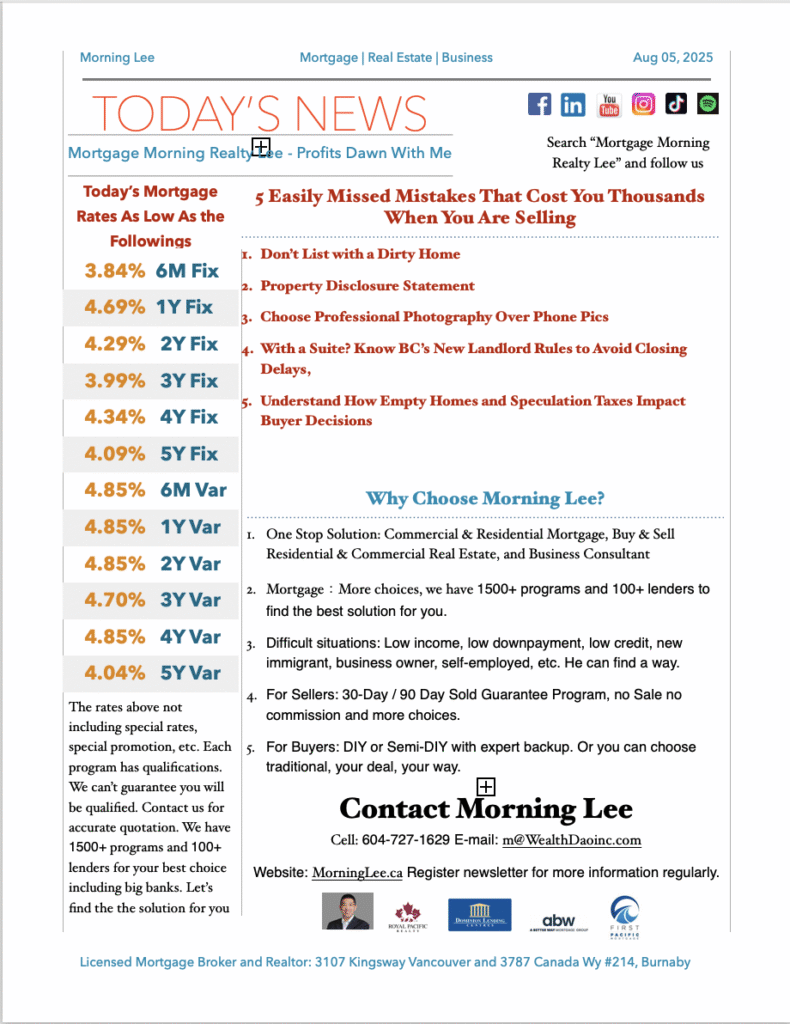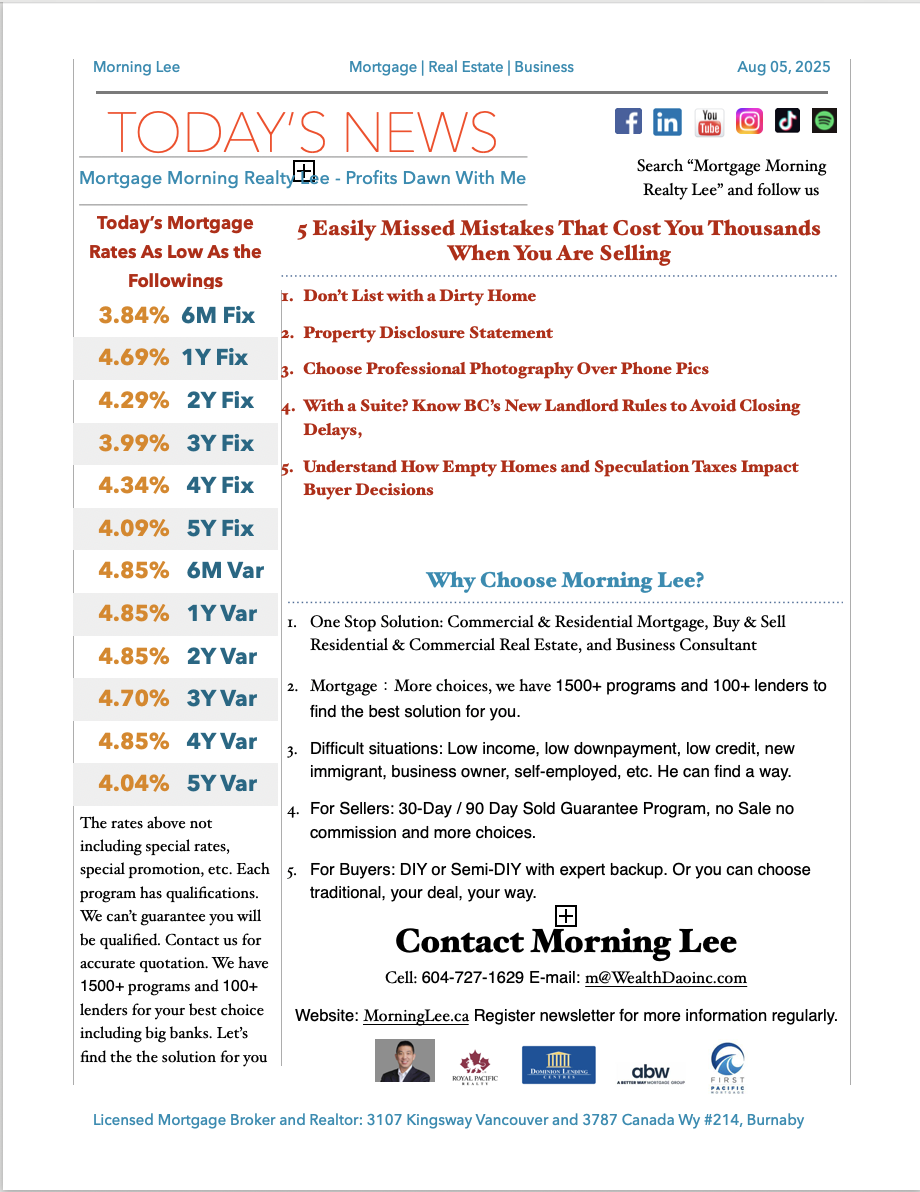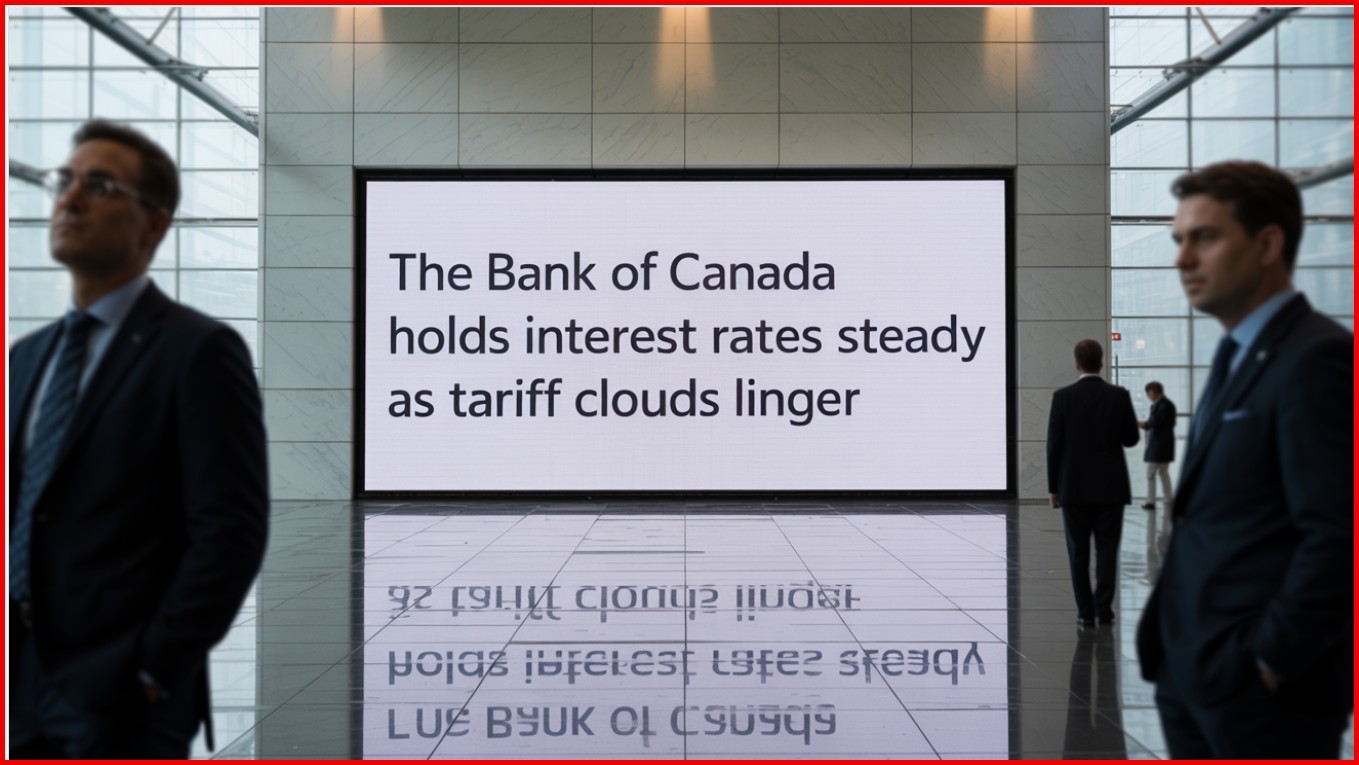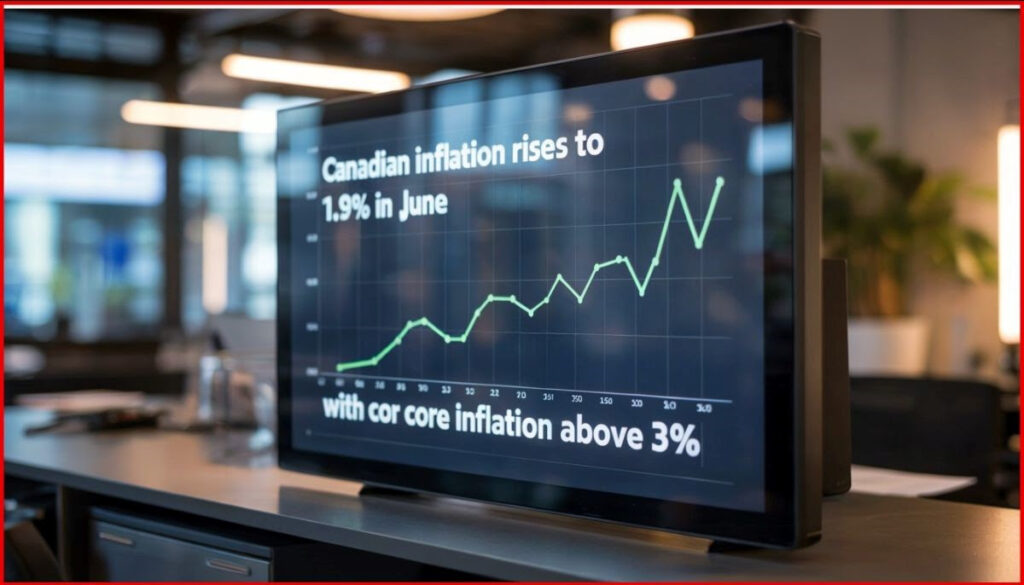Dropped! Finally dropped! We can see 3.99% now for 3-Year fixed rates.

Buy Residential Property in Vancouver, Residential Real Estate, Single Family Home, Single House, Town House, Town Home, Apartment, Condo, Duplex, Triplex, Fourplex, Best Vancouver Realtor, Best Vancouver Real Estate Agent
Buy Commercial Property – Commercial Real Estate – Commercial Realtor – Commercial Real Estate Agent
Warehouse, Industrial, Office, Retail Store, Farm, Hotel, Multi Family Building, Land Assembling, Developing Land, Church, Island, Commercial Building
Sell Commercial Property – Vancouver Commercial Realtor, Vancouver Commercial Real Estate Agent
Warehouse, Industrial, Office, Retail Store, Farm, Hotel, Multi Family Building, Land Assembling, Developing Land, Church, Island, Commercial Building, Motel
Sell Residential Property in Vancouver – Best Realtor in Vancouver – Vancouver Realtor – Vancouver Real Estate Agent
Residential Real Estate, Single Family Home, Single House, Town House, Town Home, Apartment, Condo, Duplex, Triplex, Fourplex

Dropped! Finally dropped! We can see 3.99% now for 3-Year fixed rates.


This month I’ve put together a game of This or That for you. I’m challenging you to not only pick This or That, but also to think about why it’s the better course of action. After you’ve worked through the scenario, read on for the answer and explanation. And let me know how many you got right! |
| This or That: Underpricing or Overpricing Your Home?Underpricing is a common strategy in hot markets, since a lower asking price can attract multiple buyers and cause a bidding war. You could end up selling for more than the market value, just because of the demand.Overpricing deters buyers, your home sits on the market for longer, and it transfers the power to the buyer in negotiations. So, the clear winner is underpricing your home. This or That: Selling in the Spring or Selling in the Fall?Selling in the spring means there are a lot more homes on the market at the same time, and typically an active time in the housing market. The US data shows homes sell for 1.6% more than the monthly average in the spring.Selling in the fall means less competition for sellers, and motivated buyers who want to be in a new place before the snow flies. Your real estate agent will also be less busy and can provide you more attention and better service. So, there’s no wrong answer here! This or That: Professional Staging, Cleaning and Photography or DIY?Hiring a professional for every job takes time, coordination, and money – and gets great results. To determine if it’s the right move for you, consider how much more you’d be able to sell your home for. If the costs outweigh the benefits, it might be best to skip this step.However, don’t forget that pictures of your home are where potential buyers get their first impression of your home. Without good photos and an accessible environment for viewings, a great buyer might not be interested. This one is a toss up – consulting a neutral third party like your agent or neighbour might help you decide elements are needed and what you can do yourself. One pro tip I can offer you is to use ChatGPT (or Copilot, etc.) to help you with staging and décor – just put in the dimensions and ask for the ideal layout with your existing furniture. This or That: Getting an Inspection Before or After Listing?If you get an inspection before you list, you’ll be able to get a full and unbiased review of your home. You can choose to fix any issues, or list as is with a clear picture of your home. You won’t be surprised or blindsided by a buyers’ inspection coming up with issues, you can list the property at the correct price, and you’ll be in the driver’s seat during negotiations.Letting the buyer have an inspection saves money but gives them the power to negotiate. The better course of action here is to inspect pre-listing. This or That: Renovate to Increase Your Home’s Value or Leave As-is?Homeowners often complete expensive renovations before selling their home – but frequently don’t make their money back when selling. The new owners may have different tastes, or other plans for the layout or the home (including demolition!). Not only do renovations take time, but they may also require permits, inspections, or approvals. Overall, renovations before you sell are not financially beneficial.However, some repairs are critical to selling your home. Things like a leaking toilet or a hole in the drywall could easily deter a potential buyer and lower the value of your home. The best course of action here is to complete essential repairs so that the home is ready for immediate occupancy – but not spend money on extra renovations. This or That: Using a Real Estate Agent or Listing For Sale By Owner (FSBO)?If you go the FSBO route, you take on all the stress and legal responsibility of research, showing, legal documentation and more. The main reason people choose this route is to save on the commission costs of selling a home.The benefits of using an agent are plentiful, like getting the pricing, staging and photography right. You can also rely on them for all the paperwork. If a plot twist comes up, they’re there to help. You can also benefit from having your home listed on their website and their social media accounts to get your property more visibility. The winner for the average person is to use an agent. This or That: Requiring Notice in Advance or Showing Anytime?Keeping your home clean, tidy, and free of people and pets so that it’s ready for a showing is a real challenge for sellers if they’re living in the home they’re trying to sell. But for buyers who are already in the neighbourhood, inflexibility to view your home might discourage them from coming back. That means missed opportunities to sell and maybe even a lost sale.There isn’t a clear winner here, but being as flexible as possible with potential buyers creates the most opportunities for a sale. This or That: Emotions and Instinct or Advice and Numbers?This might sound like an easy one – but not so fast! The highest bidder might not be the person you want to sell your home to. Imagine you received a thoughtful letter with an offer explaining how the buyer pictures raising their children in your home – vs more money from a developer who plans to raze the property.However, you need a cool head during important negotiations. A few issues are likely to be uncovered during the home inspection. No home is perfect, so don’t let a request for minor repairs derail the deal. The winner here is a balance of emotions and numbers – and each reader will need to find an equilibrium they can live with. |

| Bank of Canada Holds Rates Steady As Tariff Turmoil Continues |
| As expected, the Bank of Canada held its benchmark interest rate unchanged at 2.75% at today’s meeting, the third consecutive rate hold since the Bank cut overnight rates seven times in the past year. The Governing Council noted that the unpredictability of the magnitude and duration of tariffs posed downside risks to growth and lifted inflation expectations, warranting caution regarding the continuation of monetary easing. Trade negotiations between Canada and the United States are ongoing, and US trade policy remains unpredictable. While US tariffs are disrupting trade, Canada’s economy is showing some resilience so far. Several surveys suggest consumer and business sentiment is still low, but has improved. In the labour market, we are seeing job losses in the sectors that rely on US trade, but employment is growing in other parts of the economy. The unemployment rate has moved up modestly to 6.9%. Inflation is close to the BoC’s 2% target, but evidence of underlying inflation pressures continues. “CPI inflation has been pulled down by the elimination of the carbon tax and is just below 2%. However, a range of indicators suggests underlying inflation has increased from around 2% in the second half of last year to roughly 2½% more recently. This largely reflects an increase in prices for goods other than energy. Shelter cost inflation remains the biggest contributor to CPI inflation, but it continues to ease. Surveys indicate businesses’ inflation expectations have fallen back after rising in the first quarter, while consumers’ expectations have not come down”. The Bank asserted today that there are reasons to think that the recent increase in underlying inflation will gradually unwind. The Canadian dollar has appreciated, which reduces import costs. Growth in unit labour costs has moderated, and the economy is in excess supply. At the same time, tariffs impose new direct costs, which will be gradually passed through to consumers. In the current tariff scenario, upside and downside pressures roughly balance out, so inflation remains close to 2%. The central bank provided alternative scenarios for the economic outlook. In the de-escalation scenario, lower tariffs improve growth and reduce the direct cost pressures on inflation. In the escalation scenario, higher tariffs weaken the economy and increase direct cost pressures. So far, the global economic consequences of US trade policy have been less severe than feared. US tariffs have disrupted trade in significant economies, and this is slowing global growth, but by less than many anticipated. While growth in the US economy looks to be moderating, the labour market has remained solid. And in China, lower exports to the United States have largely been replaced with stronger exports to other countries. In Canada, we experienced robust growth in the first quarter of 2025, primarily due to firms rushing to get ahead of tariffs. In the second quarter, the economy looks to have contracted, as exports to the United States fell sharply—both as payback for the pull-forward and because tariffs are dampening US demand. The gap between the 2.75% overnight policy rate in Canada and the 4.25-4.50% policy rate in the US is historically wide. Another cause of uncertainty is the fiscal response to today’s economic challenges. The One Big Beautiful Bill has passed, and it will add roughly US$4 trillion to the already burgeoning US federal government’s red ink. This has caused a year-to-date rise in longer-term bond yields, steepening the yield curve. The slowdown of the housing sector since Trump’s inauguration has been a substantial drain on the economy. The Monetary Policy Report (MPR) for July states that “growth in residential investment strengthens in the second half of 2025, partially due to an increase in resale activity after the steep decline in the first half of the year. Growth in residential investment is moderate over 2026 and 2027, supported by dissipating trade uncertainty and rising household incomes.” |
 |
  |
| Bottom Line We expect the Canadian economy to post a small negative reading (-0.8%) in Q2 and (-0.3%) in Q3, bringing growth for the year to 1.2%. The next Governing Council decision date is September 17, which will give the Bank time to assess the underlying momentum in inflation and the dampening effect of tariffs on economic activity. If inflation slows over the next couple of months and the economy slows in Q2 and Q3 as widely expected, the Bank will likely cut rates one more time this year, bringing the overnight rate down to 2.50%, within the neutral range for monetary policy. Bay Street economists have varying views on the rate outlook (see chart above). While the Fed will hold rates steady today, despite the incredible pressure coming from the White House, the Bank of Canada could well cut rates one more time this year. |
| Dr. Sherry Cooper Chief Economist, Dominion Lending Centres |

If you’re looking to sell residential property in Vancouver, the timing may finally be shifting in your favour. After months of hesitation, the national housing market—particularly in key metros like Vancouver and Toronto—is showing signs of a turnaround. According to a July 2025 report from MorningLee.ca, both sales and price activity have begun to stabilize, hinting that we may be entering a more balanced and predictable phase of the market.
Let’s break down what this means for sellers in Vancouver, and why some property types might have a better window to sell than others.
The latest data shows that home sales rose while prices held steady in June 2025. Nationally, sales were up around 3% month-over-month, and the national sales-to-new-listings ratio rose to 50.1%—a shift toward balanced market conditions.
In Vancouver, this means buyer activity is creeping back despite ongoing uncertainty like tariff threats and fluctuating interest rate expectations. As MorningLee.ca notes, market momentum may simply have been delayed by a rocky economic spring—and is now resurfacing into the summer and fall.
If you’re planning to sell residential property in Vancouver, it’s essential to understand how different home types are performing:
If you’re unsure where your property stands in the cycle, now’s a good time to assess—not just emotionally, but strategically.
The report points to cautious optimism, but also underlines continued risk: the Bank of Canada held rates steady, and bond yields have risen, suggesting fixed mortgage rates may go up again. These macro factors influence how quickly deals close, or if buyers even enter the market.
So who should act now?
But if your property type tends to lag in recovery cycles, or if buyer traffic is light in your area, patience may still be the better strategy. Either way, strategic timing is key—and understanding where the market cycle is headed will help you plan smarter.
In a shifting market, data is your best friend. From price stabilization to listing trends, the latest report from MorningLee.ca offers a detailed pulse check on what’s real, what’s emerging, and what risks are still looming. Whether you’re a homeowner considering selling, a buyer looking to enter before rates rise, or someone navigating mortgage financing in a bumpy cycle—understanding these signals can make all the difference.
And before you make any move, make sure your property has no hidden red flags. Visit https://estatedetect.com to get an in-depth risk review before you buy or sell. Peace of mind is the best market strategy.


When homeowners plan to sell residential property in Vancouver, their focus often falls on big-picture items—pricing, staging, and timing. But the reality? Overlooking just a few small details can quietly drain your final sale price or even kill the deal entirely.
In today’s stabilizing market, where buyers are cautious and inventory is tightening, every detail counts. Below, we break down five surprisingly common missteps sellers make—especially in the Greater Vancouver area—and how to avoid them.
👉 Read: Home Sales Rose As Prices Stabilized – Housing Market is Turning a Corner
First impressions matter. And in Vancouver’s competitive market, buyers walk into an open house already comparing your home to the next five on their list. A cluttered kitchen, dusty blinds, or unkempt yard doesn’t just create bad vibes—it leads to lowball offers or buyers walking away.
Professional deep cleaning before listing isn’t a luxury—it’s part of the selling strategy. It affects perceived value and, by extension, final sale price.
In B.C., the Property Disclosure Statement (PDS) isn’t legally mandatory—but buyers and agents expect it. It’s a red flag when missing. Forget to disclose past water damage or unresolved plumbing issues, and your deal may fall apart during due diligence.
To sell residential property in Vancouver successfully, your paperwork needs to be clear, transparent, and ready before listing. This is especially important when mortgage lenders get involved—missing disclosures can delay financing approvals.
Think your smartphone is “good enough”? Data says otherwise. Listings with professional photos attract more clicks, more showings, and often sell for higher prices.
According to REDFIN, professionally photographed homes sold for $3,400 to $11,200 more on average than those with amateur photos. In Vancouver, where a 1% pricing shift can mean tens of thousands, this isn’t a detail—it’s strategy.
Planning to sell a home with a secondary suite (basement rental, laneway house, etc.)? B.C. has recently updated its tenancy and property-use regulations. Not understanding your obligations as a seller—especially regarding notice periods or compliance with rental bylaws—can lead to legal trouble or buyer hesitation.
If you’re listing a home with tenants, make sure you’re aligned with the Residential Tenancy Act, or you risk unexpected delays.
Sellers often forget that buyers factor future taxes into their offers. The Empty Homes Tax (EHT) in Vancouver and Speculation and Vacancy Tax (SVT) in B.C. can significantly impact how appealing your property is to out-of-town or investor buyers.
Properties flagged as “vacant” or subject to speculative taxes often sit longer on the market or fetch lower bids. Transparency about current tax status is crucial.
To explore whether a property has hidden risks, we recommend tools like EstateDetect.com—a smart way for buyers to investigate before they commit.
To sell residential property in Vancouver without leaving money on the table, sellers need more than just a “For Sale” sign—they need a solid understanding of paperwork, presentation, and market trends.
Need help navigating the details? Visit MorningLee.ca to work with professionals who know how to position your home—and your loan—for success.


For many first-time homebuyers, the dream to buy residential property in Vancouver can feel just out of reach—especially when it comes to saving up enough for a down payment. With Vancouver’s competitive residential real estate market and rising prices, even a modest home can require a sizable upfront investment. But here’s the good news: falling short on your down payment doesn’t always mean putting your homeownership plans on hold. Let’s explore three proven solutions that may help you get into your new home sooner than you think.
Canada’s down payment structure depends on many factors:
Finding the right bank and right program among so many of them is super important. About this, a mortgage broker is the best choice for you.
There are many assisting programs and special programs by governments, especially for young people, first-time home buyers, special situations.
For example, the First-Time Home Buyer Incentive (FTHBI) might be an option. This federal program allows eligible buyers to borrow 5% or 10% of the home’s purchase price to put toward the down payment. The incentive is repayable, interest-free, and designed to make monthly mortgage payments more manageable.
For details, please check out the government information here
If you want to get more and updates about this kind of information, please register our newsletter to receive related news, updates, polices, etc.
Another common method for buyers in Vancouver is receiving gifted down payments from close family. Most Canadian lenders accept this form of funding—provided there’s clear documentation that it is indeed a gift, not a loan.
Your lender will typically require:
Remember, the source of your down payment is heavily scrutinized by lenders and underwriters. Legal transparency is key.
In today’s market, many buyers rely on the guidance of a mortgage broker to access lenders who accept non-traditional down payment sources, such as borrowed funds against other assets or cash flow from side businesses. Not all banks will work with these types of arrangements—but alternative lenders and B-lenders often will, especially with the right documentation and a solid income history.
This is where professionals like those at MorningLee.ca come in. With experience in both real estate and financing, they can connect you with lenders who look beyond just the big five banks.
If you’re stretching your finances to secure a home, the last thing you want is a surprise repair bill. Before you buy, consider using tools like EstateDetect.com — a platform that helps homebuyers investigate property risks and hidden issues, giving you peace of mind and negotiation power.
As home sales rise and prices begin to stabilize, Vancouver’s real estate market is entering a window of opportunity. Acting now—with the right financial strategy—can make all the difference.
And if you’re ready to take the next step, MorningLee.ca is here to help guide you through both the buying and financing process—professionally, efficiently, and with your best interest in mind.



Canadian consumer prices accelerated for the first time in four months in June, and underlying price pressures firmed, likely keeping the central bank from cutting interest rates later this month.
The annual inflation rate in Canada rose to 1.9% in June from 1.7% in May, aligning with market expectations. Despite the pickup, the rate remained below the Bank of Canada’s mid-point target of 2% for the third consecutive month.
Headline inflation grew at a faster pace, as gasoline prices fell to a lesser extent in June (-13.4%) than in May (-15.5%). Additionally, faster price growth for some durable goods, such as passenger vehicles and furniture, put upward pressure on the CPI in June.
Prices for food purchased from stores rose 2.8% year-over-year in June, following a 3.3% increase in May.
Year over year, the CPI excluding energy (+2.7%) remained higher than the CPI in June, partly due to the removal of consumer carbon pricing in April.
Monthly, the CPI rose 0.1% in June. On a seasonally adjusted monthly basis, the CPI was up 0.2%.

The Bank of Canada’s two preferred core inflation measures accelerated slightly, averaging 3.05%, up from 3% in May, and above economists’ median projection. The three-month moving annualized average of the core rates surged to 3.39%, from 3.01% previously.
There’s also another important sign of firmer price pressures: The share of components in the consumer price index basket that are rising by 3% or more — another key metric the central bank’s policymakers are watching closely — expanded to 39.1%, from 37.3% in May.

Bottom Line
The chart below, created by our friends at Mortgage Logic News, shows that Canadian economic data have come in stronger than expected on average in recent weeks. This was evident in the June employment report. As a result, the Bank of Canada is likely to remain on the sidelines on July 30 for the third consecutive meeting. The Canadian economy appears to be weathering the tariff storm better than expected, at least for now.
While we expect to see a negative print on Q2 GDP growth, a bounce back to positive growth in Q3 is also possible, precluding the much-expected Canadian recession.
The June inflation data, released today for the US, was weaker than expected for the core price index. Declines in car prices helped mitigate tariff-related increases in other goods within the US consumer basket.
The US inflation data could draw even greater calls from President Trump for the Federal Reserve to lower interest rates. While some officials have expressed a willingness to cut rates when the central bank meets in two weeks, policymakers are generally still divided as to whether tariffs will cause a one-time price shock or something more persistent. They will leave rates unchanged for now.

Dr. Sherry Cooper


The number of home sales recorded over Canadian MLS® Systems rose 2.8% on a month-over-month basis in June 2025, building on the 3.5% gain recorded in May.
Over the past two months, the recovery in sales activity has been led overwhelmingly by the Greater Toronto Area (GTA), where transactions, although remaining historically low, have rebounded by a cumulative 17.3% since April.
“At the national level, June was pretty close to a carbon copy of May, with sales up about 3% on a month-over-month basis and prices once again holding steady,” said Shaun Cathcart, CREA’s Senior Economist. “It’s another month of data suggesting the anticipated rebound in Canadian housing markets may have only been delayed by a few months, following a chaotic start to the year; although with the latest 35% tariff threat, we’re not out of the woods yet.”

New Listings
New supply declined by 2.9% month-over-month in June. With sales up and new listings down, the national sales-to-new-listings ratio rose to 50.1%, up from 47.3% in May. The long-term average for the national sales-to-new listings ratio is 54.9%, with readings between 45% and 65% generally consistent with balanced housing market conditions.
There were 206,435 properties listed for sale on Canadian MLS® Systems at the end of June 2025, up 11.4% year-over-year and just 1% below the long-term average for that time of the year.
“Most housing markets continued to turn a corner in June, although market conditions still vary considerably depending on where you are in Canada,” said Valérie Paquin, CREA Chair. “If the spring market was mostly held back by economic uncertainty, barring any further big shocks, that delayed activity could very likely surface this summer and into the fall.”


Home Prices
The National Composite MLS® Home Price Index (HPI) was little changed (-0.2%) from May to June 2025, following three straight month-over-month declines of closer to 1% in February, March, and April.
The non-seasonally adjusted National Composite MLS® HPI was down 3.7% compared to June 2024. Based on the extent to which prices fell off in the second half of 2024, expect year-over-year declines to shrink in the months ahead.

Bottom Line
There is every indication that the housing markets in the GTA and the GVA are beginning to perk up following a disappointing Spring market. Sales generally increased in May and June, and new listings fell last month. The price data suggest a flattening in prices. Tariff uncertainty has swamped the psychology of many potential buyers, who are reticent to make a move. The latest 35% tariff threat from Washington doesn’t help.
And while the central bank was expected to lower interest rates further, it took a pass at the prior two meetings and is likely to do so again on July 30th when it meets. This morning’s CPI release for June showed a continued rise in core inflation, effectively ruling out a BoC rate cut.
Moreover, longer-term interest rates are market-driven and have been trending higher since March, when tariff sabre-rattling began in earnest. Canada’s five-year government bond yield broke above its key 3% support level in the past week. This could well trigger another rise in fixed mortgage rates. Furthermore, the Canadian two-year yield is 2.83%, which is above the Bank’s overnight policy rate of 2.75%. This suggests that monetary easing in Canada may be over for this cycle, provided the economy remains resilient. Of course, given the TACO issue (an acronym that stands for Trump Always Chickens Out), any forecast bears more than the usual uncertainty.


Dr. Sherry Cooper

In today’s thriving real estate market, understanding how to buy commercial property in Vancouver is more important than ever. Whether you’re an investor looking to expand your portfolio or a local entrepreneur securing a storefront, navigating Vancouver’s commercial real estate landscape requires a combination of market knowledge, legal awareness, and strategic financing.
Vancouver is one of Canada’s most dynamic cities, with a commercial real estate sector that continues to show strong potential. Whether you are eyeing retail, office, or mixed-use spaces, knowing how to buy commercial property successfully hinges on local regulations and expert guidance.
The city has specific zoning laws, environmental requirements, and property taxes that differ significantly from residential purchases. Due diligence is essential—not just in property inspection, but also in verifying leasing history, tenant stability, and zoning compliance.
Before entering the market, clarify your objective: Are you buying to lease? Develop? Flip? Your goals will determine the type of property you seek and your budget. An experienced real estate agent in Vancouver can help analyze risk, ROI, and market trends.
Commercial mortgages often require a higher down payment—typically 25-35%. Rates may differ depending on the asset type and borrower profile. For business owners or new investors, working with a mortgage advisor who understands the Vancouver market is crucial.
Consider visiting WealthDaoConsulting.com, a platform offering insights on digital marketing, SEO, and business financing. Their article on E-Commerce Essentials: Building Your Online Empire From the Ground Up draws parallels between business development and strategic property investment—both require a solid foundation and growth mindset.
Before signing anything, conduct a full review of the building’s title, environmental compliance, and any existing lease agreements. It’s also vital to understand GST obligations, which differ from residential transactions.
This is where having a real estate agent in Vancouver proves invaluable—they can help identify red flags, refer you to legal experts, and guide negotiations.
Avoiding these pitfalls requires not just awareness but partnership with local experts who know the terrain.
A professional real estate agent in Vancouver does more than show properties. They provide market insights, negotiate deals, and ensure legal compliance—especially vital when you buy commercial property in a competitive market like this.
Whether you’re a first-time buyer, experienced seller, or someone exploring mortgage options, platforms like MorningLee.ca offer tailored guidance to navigate Vancouver’s real estate and financing opportunities with confidence.
For personalized advice on your next real estate or mortgage decision, visit MorningLee.ca—your trusted partner in Vancouver’s commercial property market.
